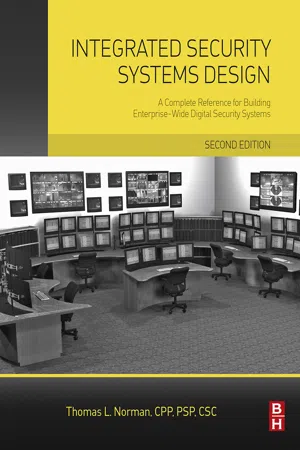The tools of design include drawings, specifications, interdiscipline coordination, product selection, project management, and client management.
Drawings
Drawings are the heart of the design. Drawings are discussed in detail in Chapter 10, but it is important to understand their strategic role in the process, which is described here. Drawings should show the following:
• The relationship of devices to their physical environment (plans, elevations, and physical details)
• The relationship of devices to the conduit system and to power (plans and risers)
• The relationship of devices to each other (single line diagrams)
• The relationship of devices to the user (programming schedules)
Drawings must serve five distinct types of users:
• The bid estimator: The bid estimator must determine what materials are needed. Helpful drawing tools include device schedules (spreadsheets listing devices and their attributes) and plans showing device locations and conduit lengths, sizes, and wire fills. Other drawings useful to the bid estimator include single line diagrams, riser diagrams, and system interfacing diagrams.
• The installer: The installer needs drawings that show both the big picture and the smallest details. Therefore, it is helpful if the drawings are formatted in a hierarchical fashion. Single lines show the big picture. Plans show device locations and their relationship to the building and conduit system. Physical details and interface details show the smaller details.
• The project manager: The project manager needs to manage the progress of the installation, including coordinating the ordering and arrival of parts and supplies and coordinating manpower to the project at the correct time, in the correct place, and in coordination with other trades to get all devices mounted and all connections made. He or she will primarily rely on schedules for provisioning logistics, plans to measure installation progress, and single-line diagrams to gauge how close the system is to start-up.
• The maintenance technician: After the system is installed, it is the maintenance tech’s turf. He or she will need single-line diagrams to determine how the system interconnects, plans to determine where devices are located and how they connect in the physical space, and risers and power schedules to know where to go from floor to floor and the source of power for each device. The integrator should be required to provide maintenance manuals that have all these drawings. I also recommend that the integrator be required to place a pocket on the inside door of each electronics assembly with an envelope containing the system single-line diagram, riser, and plans appropriate to service the equipment in that rack. Also, he or she should be required to install a field intercom station at each service location to communicate with the console to facilitate communications with another technician or console operator.
• The next engineer expanding the system: Many systems undergo expansion on an irregular basis. You may not be the next engineer, but someone will be. He or she will need all of your drawings in order to understand how to expand the system. The client should receive all your drawings in AutoCAD® form and specifications in Adobe PDF form.
Specifications
Specifications are discussed in detail in Chapter 10, but it is important to understand their strategic role in the process, which is described here.
If drawings are the heart of the design, specifications are the head. Specifications generally take precedent in legal disputes. Drawings are just there to illustrate the standards and practices written into the specifications. If you are very long in your career, you will see some pretty bad specs. We used to joke in our office about someday seeing a set of specifications that simply says “Make it work real good.” Some come pretty close to that. We have seen security system specifications that are only five pages long. There is a lot of room there for serious mistakes by a well-meaning contractor. Many security system contracting problems are the result of incomplete or wrong specifications.
With possibly very few exceptions, most integrators I have met sincerely want to do well for their clients. It is the designer’s job to provide the integrator with enough information to do well. To the extent that drawings and specifications are incomplete, inaccurate, or misleading, the contractor can make unintended errors that will be costly and aggravating to the installer, the integrator for whom he or she works, and most certainly the system’s owner.
Specifications should include a description of what the project entails; descriptions of the whole integrated system and each subsystem; a description of the services the contractor will provide; and a list of acceptable products and acceptable installation, testing, acceptance, training, and warranty practices. Different specification formats prevail in different areas of the world, and occasionally these may change as building code authorities evolve in their preferences. This will all be covered in detail in Chapter 10.
Product Selection
Specifying the correct products for the job can result in a wonderful system that can easily exceed the owner’s expectations. The wrong products can leave the owner upset with the installer, the manufacturer, and the designer. Here is where the designer has to have free reign to do what is in the best interest of the client. To the extent that the designer is placed under pressure to specify one brand or another due to market forces, I assure you that the owner will suffer. If the owner suffers, everyone suffers. The operator suffers, the maintenance tech suffers, the integrator who has to listen to an unhappy client suffers, the manufacturer suffers, and the industry suffers. Countless manufacturers and integrators have lost repeat work (and lost client referrals) due to expediencies in ...
